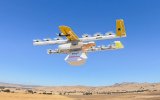ChillyFlyer
Member
Imagine a flying pipe. A 20' long pipe, 2-1/2" diameter. The pipe is to fly horizontally, not end on but side on. The pipe (boom) is to bea loaded with a fluid and spray that fluid through orifices on the underside of the boom. The pipe will have baffles within to ensure fluid does not flow laterally and gather at one end. The pipe is to fly horizontally about 6" from a plant canopy which itself is anywhere from 4-36" tall. I would suppose the unit needs some side props to control sliding to the side.
Flight path:
The unit is to spray fluid over an area, line upon line. The unit will sit on a trailer at one end of the area. The unit takes off, sprays it's fluid down the length of the area. At the end it stops, slides over one flying boom width (20') and sprays back. It lands onthe trailer which has also moved over 20'. On the trailer it gets repressurized with fluid and has it's batteries changed. The trailer is moved ahead another 20' and the unit takes off for another 2 passes out and back.
Is this possible?
If so, where do I start? Can a system handle, for example, the side slip and then proper reaction with powering end props to keep it from slipping?
Fluid weight is about 50lb on 20' of boom or 2.5 lb/ft. While I'm sure titanium would be nice and light and strong I cannot work with that. I can do aluminum, probably molybdenum.
Thank you for your input.
Flight path:
The unit is to spray fluid over an area, line upon line. The unit will sit on a trailer at one end of the area. The unit takes off, sprays it's fluid down the length of the area. At the end it stops, slides over one flying boom width (20') and sprays back. It lands onthe trailer which has also moved over 20'. On the trailer it gets repressurized with fluid and has it's batteries changed. The trailer is moved ahead another 20' and the unit takes off for another 2 passes out and back.
Is this possible?
If so, where do I start? Can a system handle, for example, the side slip and then proper reaction with powering end props to keep it from slipping?
Fluid weight is about 50lb on 20' of boom or 2.5 lb/ft. While I'm sure titanium would be nice and light and strong I cannot work with that. I can do aluminum, probably molybdenum.
Thank you for your input.


